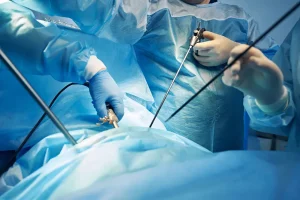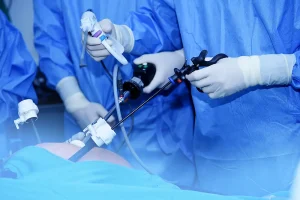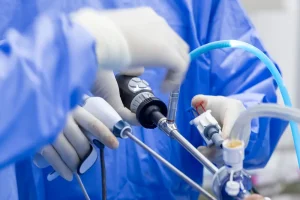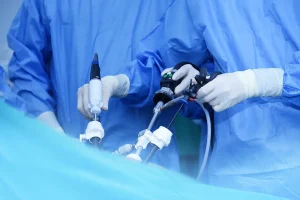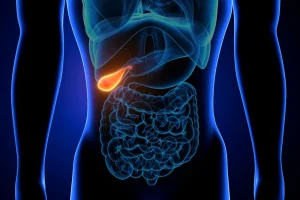Lymphadenectomy
How it makes a difference in cancer diagnosis and control
Home » General Laparoscopic Surgery » Lymphadenectomy
Medical Procedures
Laparoscopic Interventions
Classic Surgical Interventions
Abdominal Conditions
Pelvic and Perineal Conditions
Other Conditions

Lymphadenectomy is more than just a surgical intervention—it is a critical step in the diagnosis and management of cancer. By removing affected lymph nodes, doctors gain essential information about the stage of the disease and can tailor the most effective treatment plan. This precision gives patients a real chance at recovery and long-term disease control.
Book an Appointment
What Is Lymphadenectomy?
Lymphadenectomy is a surgical procedure involving the removal of one or more lymph nodes. It is widely used in oncology to diagnose or limit the spread of cancer. Lymph nodes, an integral part of the immune system, are located in the neck, armpits, groin, and abdominal region. Their removal plays a crucial role in both staging the disease and selecting appropriate therapeutic strategies.
At VenArt Clinic, patients benefit from modern techniques, a multidisciplinary medical team, and personalized care in a safe, professional setting.
Types of Lymphadenectomy by Anatomical Area
Depending on the region affected by cancer, lymphadenectomy is categorized into several types. Each type has specific indications based on the tumor location and type of malignancy:
- Axillary lymphadenectomy: Performed in cases of breast cancer, this procedure removes lymph nodes from the armpit area;
- Inguinal lymphadenectomy: Targets the lymph nodes in the groin and is frequently indicated for melanoma, as well as penile, anal, or vulvar cancers;
- Pelvic lymphadenectomy: Involves removing lymph nodes in the pelvic region, commonly in prostate, bladder, and rectal cancers;
- Cervical lymphadenectomy: Removes lymph nodes from the neck area and is used in cancers of the head, neck, larynx, and thyroid;
- Retroperitoneal lymphadenectomy: Excises deep lymph nodes behind the peritoneum and is primarily indicated in testicular cancer, and sometimes ovarian cancer;
- Mediastinal lymphadenectomy: Involves removing lymph nodes in the chest cavity between the lungs, often for lung cancer and lymphomas.
When Is Lymph Node Removal Recommended?
Lymphadenectomy is primarily indicated in oncology to assess cancer progression and define staging. Beyond staging, the procedure serves a therapeutic role by removing potentially metastatic lymph nodes, thereby reducing recurrence risk and improving disease control.
It is also occasionally used in non-cancerous conditions, such as chronic infections (e.g., lymph node tuberculosis) or autoimmune diseases (e.g., sarcoidosis, lupus), particularly when the nodes do not respond to medical treatment or require biopsy for diagnosis.
How Is Lymphadenectomy Performed?
Lymphadenectomy is a surgical intervention that consists of removing one or more lymph nodes and plays a critical role in both the diagnosis and treatment of various types of cancer.
The specific surgical approach depends on the anatomical location of the lymph nodes and the patient’s overall clinical status. Most procedures are performed under general anesthesia, ensuring the patient’s comfort and safety throughout the operation. In an open lymphadenectomy, the surgeon accesses the area through a single incision, the size of which may vary depending on the complexity of the case.
Minimally invasive alternatives, such as laparoscopic or robotic-assisted techniques, involve several small incisions through which a high-definition camera and precision instruments are introduced.
The lymph nodes are excised with care, sometimes along with adjacent tissue when necessary, and sent for detailed histopathological examination. After removal, a drainage tube is commonly placed to prevent fluid build-up at the surgical site. The incisions are then closed with sutures or staples, and sterile dressings are applied, followed by continuous monitoring during the recovery phase.
What Are the Risks and Benefits of Lymphadenectomy?
The main benefit of lymphadenectomy is accurate staging and removal of regional metastases, which is vital for planning effective cancer treatment. It can significantly impact outcomes by reducing the risk of recurrence.
As with any surgery, risks exist. These include:
- Infection;
- Bleeding;
- Seroma formation;
- Lymphedema, or lymph fluid accumulation, which is more likely with extensive node removal (radical lymphadenectomy).
Why Choose the VenArt Clinic?
At VenArt Clinic in Cluj-Napoca, patients benefit from a high standard of oncologic and lymphatic surgical care. Our dedicated team of specialists combines extensive experience with advanced medical technologies to ensure both safety and efficiency at every step.
From the very first consultation, patients receive expert guidance and thorough evaluation tailored to their unique needs. Through close multidisciplinary collaboration and attentive follow-up, we help ensure a smooth, supported recovery for each individual we care for.
Medical Team
Frequently Asked Questions
How Should I Prepare for Lymphadenectomy?
Preparation includes a comprehensive health assessment, medical history review, and evaluation of current medications. Your doctor may request blood tests, imaging (ultrasound, CT, MRI), or biopsy. Patients must sign an informed consent form after receiving a detailed explanation of the procedure. Fasting is usually required several hours before surgery.
How Is Recovery After Surgery?
Recovery depends on the surgical approach and individual health status. Most patients are hospitalized for a few days for monitoring and pain control. After discharge, instructions include wound care, dressing changes, and activity restrictions. Strenuous activities should be avoided until the doctor confirms full healing.
Is Lymphadenectomy a Painful Procedure?
The procedure itself is not painful, as it is performed under general anesthesia. Some discomfort may occur at the incision site during recovery, but it is manageable with pain medications prescribed by the doctor.

